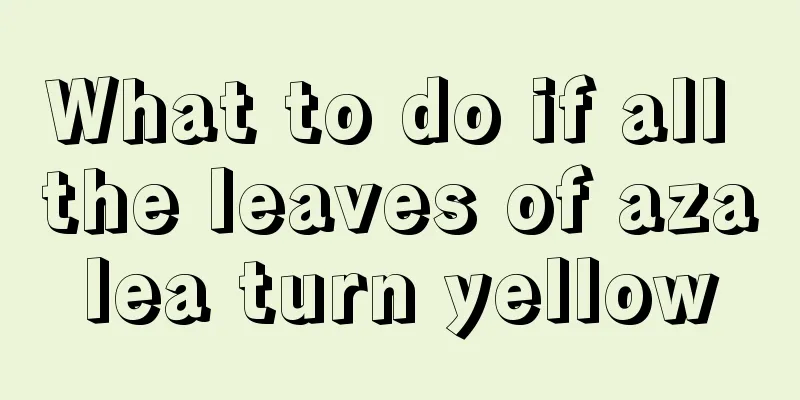What to do if all the leaves of azalea turn yellow

OverwateringExcessive watering and long-term overwet soil in the pot will cause oxygen deficiency in the soil, causing some fibrous roots to rot, hindering normal breathing and absorption of water and nutrients, and causing the leaves to turn yellow and fall off. After being infected, the young leaves first turn light yellow, and then the old leaves gradually turn yellow. You should immediately control watering, stop fertilizing, and loosen the soil frequently to ensure good ventilation. Drought and dehydrationIf you forget to water the flowers or only water them halfway for a long time ( i.e. wet on the top and dry on the bottom ) , it will affect nutrient absorption and easily cause the leaves to become dull and wilt. First, the old leaves at the bottom age and gradually turn yellow and fall off from bottom to top. At this time, a small amount of watering and spraying is required to allow it to gradually recover before returning to normal watering. Long-term weight lossIf ammonia fertilizer is not applied or the pot and soil are not changed for a long time, the soil will lack nutrients such as nitrogen, resulting in weak branches and leaves and thin and yellow leaves. It is necessary to turn the pot over in time, replace it with new loose and fertile culture soil, and gradually apply thin and well-rotted liquid fertilizer or compound flower fertilizer. OverfertilizationIf too much fertilizer is applied, the new leaves will become thick and uneven, and the tips of the old leaves will become dry, brown and fall off. Stop fertilizing immediately, increase the amount of watering, so that the fertilizer flows out from the drainage holes at the bottom of the pot, or immediately turn the pot over, rinse the soil with water and then replant it in the pot. Hot and hotIf flowers are placed in a high temperature place and exposed to direct sunlight in the summer, it is very easy to cause the tips and edges of young leaves to burn, or the leaves to turn yellow and fall off. It needs to be moved to a well-ventilated, cool place in time. Excessive shadeIf flowers that love sunlight are placed in the shade or in a place with insufficient light for a long time, their branches and leaves will grow too long, their leaves will become thin and yellow, and they will not bloom or bloom very rarely. Be sure to move the flowerpot to a sunny location. Alkaline soil and waterThe soil and water in most areas of the north contain a lot of salt and alkali. Rhododendron is a flower that prefers acidic soil. Due to the lack of soluble iron and other elements that can be absorbed by it in the soil, the leaves will gradually turn yellow. When planting, choose acidic soil and water with alum fertilizer frequently during the growth period. AirtightIf too much nitrogen fertilizer is applied, the branches and leaves will grow too luxuriantly, and if they are not pruned for a long time, the inner branches and leaves will not receive enough light, which can easily cause the leaves to turn yellow and fall off. Reasonable fertilizer application and increased pruning should be carried out to ensure ventilation and light transmission. Air DryingWhen the indoor air is too dry, the tips of flowers and plants often dry out or their edges burn. It is necessary to take measures such as spraying water and covering with plastic film to increase the air humidity. Improper temperatureThe room temperature is too low in winter, and flowers that prefer high temperatures are often susceptible to cold damage, causing the leaves to turn yellow, and in severe cases, they may wither and die. If the room temperature is too high, the plant will transpire too much, and the roots will not be able to meet the demand for water and nutrients, which will also cause the leaves to turn yellow. Please pay attention to adjust the room temperature in time. Pests and diseasesLeaf spot disease caused by fungi and other pathogens can easily cause local necrosis of leaves, with yellow spots or plaques appearing, and in severe cases the entire leaf will turn yellow and fall off. After being infected by the mosaic virus, yellow and green spots will appear on the leaves. When attacked by scale insects, red spiders, etc., the leaves will also turn partially yellow and wither, or even wilt and fall off. All should be sprayed with pesticides in time for prevention and control. Strong sexual stimulationUsing too high a concentration of pesticides when preventing and controlling pests and diseases, or being polluted by toxic gases in the atmosphere, or suddenly watering with cold water when the temperature is high, can easily cause the leaf tips or parts of the leaf surface to turn yellow and wither, or even cause the entire plant to die. Therefore, we should pay attention to the rational use of pesticides and try to eliminate the sources of air pollution. Avoid watering flowers with cold water around noon in midsummer. Finally, it should be mentioned that the yellowing leaves of potted flowers are sometimes caused by one reason, but often it is caused by multiple factors. A correct diagnosis should be made before the right medicine can be prescribed. |
<<: What to do if the leaves of hydroponic green radish turn yellow
>>: What to do if the leaves of Chlorophytum comosum turn yellow
Recommend
Do Gypsophila seeds need to be soaked in water before planting (how long and how to soak in water)
1. Do seeds need to be soaked in water? Before it...
How to cultivate Prunella vulgaris
1. Maintenance methods 1. Temperature: Prunella v...
Which month is suitable for planting osmanthus trees?
When to plant osmanthus trees Spring and autumn a...
What to do if the leaves of Milan turn yellow
Low temperature The yellowing of Milan leaves oft...
Is the money tree poisonous?
Is the money tree poisonous? The money tree is in...
Can the dragon's vomit be placed in the bedroom?
1. Can it be placed in the bedroom? 1. This plant...
The propagation technique of Jianlan
Introduction to Jianlan Jianlan, also known as Fo...
How to grow a money tree in a pot? How to grow a money tree in a pot
How to cultivate money tree in potted plants 1. P...
If you like to grow vegetables, you should have these tools at home
Shovel Used for transplanting seedlings and shove...
What is the best season to plant longan?
Longan planting season and time The planting time...
When is the best time to plant wild rice?
Fried water bamboo shoots with meat and fried wat...
How to Graft Christmas Cacti
1. Time of grafting The time for grafting can be ...
Four Seasons Maintenance Tips for Red Flower Jade
Spring and Autumn Maintenance The red flower jade...
Garlic and onion planting method and time when is the best time to plant
Suitable planting time for garlic and onion Garli...
Causes and treatments of yellow leaves of Houttuynia cordata
1. Lack of water Reason: Houttuynia cordata likes...









